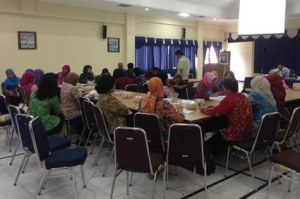Tracking finances for cross-sectoral priorities
Common lessons from experiences in nutrition, child protection and gender
Stephanie Allan
12 May 2015
/
- 0 Comments

UNICEF workshop in central Java to map child protection services provided at provincial and district level (S Allan).
Sectors are the spinal column of the public sector, offering an orderly and pragmatic way of arranging public sector affairs and dicing up resources. The boundaries between them, however, are more arbitrary than is commonly acknowledged. This has become more apparent in recent year as a number of issues which don’t fit comfortably in any of the ascribed boxes have risen up the global development agenda. One such issue is nutrition, where amassing scientific evidence has underscored the necessity of a multi-sectoral approach that goes beyond the health sector to stem the underlying causes of malnutrition. Another is child protection, which to adopt UNICEF’s definition concerns the prevention and response to violence, exploitation and abuse against children, a task that cannot fall to any single sector alone. Similar issues also arise from more longstanding cross-sectoral concerns, such as gender or HIV/AIDS.
The challenges faced when working on issues that cross sectoral boundaries are many, but this article will focus on financial tracking. Financial tracking has received growing attention in recent years, in large part due to heightened demand for transparency and accountability around public expenditure (both in developing country budgets, and in aid budgets), fuelled by a combination of austerity measures, use of modalities like budget support and results-based financing, and stronger and more active civil societies.
Financial tracking, in and of itself, demands robust PFM systems in order to generate reliable financial data, disaggregated to the necessary level of detail. It also requires a willingness to share timely information which is often lacking (on the part of donors and NGOs, as well as governments). Financial tracking for cross-sectoral priorities, however, poses some unique challenges above and beyond these. Because budgets and financial systems are built to mirror sectoral structures they do not instinctively delineate for issues that transcend those structures. The tools we have developed don’t fit the task at hand; it’s like slicing a cake to work out how much flour went into it.
Two recent Mokoro assignments have underscored this challenge. In the evaluation of the Scaling Up Nutrition (SUN) Movement we considered the way the movement has tried, with only modest success, to track resources spent on nutrition in member countries as a means of strengthening accountability around the substantial financial commitments for nutrition that have been made. For UNICEF, we are developing a methodology for measuring public expenditure on child protection to form the basis of a cross-country comparison benchmark to be used for advocacy purposes. Whilst dealing with very different thematic concerns, the challenges faced are not dissimilar, and one can draw from these assignments and from experiences in gender a number of shared lessons and points for consideration.
One of the complexities related to tracking cross-sectoral expenditures relates to how you estimate expenditures when they are bundled into bigger programmes. This is a particularly common problem for cross-sectoral issues, where responsibilities are split between different ministries and agencies and as a result tend to get subsumed under their larger, more prominent programmes. For instance, with respect to nutrition, you might find treatment of malnutrition lumped into a bigger health intervention falling under the auspices of the Ministry of Health. For child protection, it is sometimes the case (as we’ve found in Indonesia), that protection services to children are bundled in with protection services to women.
Introducing a specific budget line for nutrition, or for child protection, is one potential tool that has been used to address this issue. Budget lines work by applying a code to qualify expenditures (which can cut across ministries, and programmes) making it possible to identify and isolate them. It also can prevent funds that are allocated to a particular priority programme from being re-allocated mid-year to other government spending priorities. Amongst SUN countries there is a great deal of enthusiasm about the potential use of nutrition budget lines, although only a few countries were found to be applying them in practice and there are sound reasons to temper expectations around them. Firstly, they only work in countries that have a programme-based budget structure (which in itself assumes a requisite level of PFM capacity). Secondly, they are often misconceived to be a means of increasing funding to the priority expenditure, but whilst budget lines can support ex-post analysis of expenditures, they do not necessarily mean a specific allocation in the appropriations. Additionally, salaries and overhead costs, which represent a significant proportion of expenditure in these areas, are often not delineated through the budget line and will most likely be reported as part of the government’s overall payroll and administrative costs.
These limitations of budget lines, coupled with their fairly limited use in PFM systems in the developing world, mean that financial tracking exercises will invariably require some sort of apportioning to estimate how much of a given expenditure is for the particular priority under consideration. The data used for the apportioning will depend on what is available and appropriate. For instance, with regards to child protection in Indonesia, we found that most shelters cater for neglected and abused children and women, but beneficiary data allows us to apportion their budget according to the number of cases that are under 18. In other instances it might be necessary to use staff costs as a proxy, for instance estimating the proportion of time spent by a health worker treating malnutrition as compared to the other treatments delivered by the health facility. What is certain is that this demands additional data collection beyond what is provided in budget documentation, and this can be time-consuming and costly to collect.
Another challenge associated with tracking expenditures for cross-sectoral priorities relates to how one captures programmes which impact on the concerned field, but only do so indirectly. In nutrition, these are termed “nutrition-sensitive” expenditures, and an example might be a school feeding programme which aims to improve enrolment rates, but by providing a nutritious meal also addresses malnutrition as a by-product. These sensitive-type expenditures are common to all cross-sectoral themes, including gender and child protection, and pose difficulties because they wouldn’t be picked up in a budget line (which works as a single, self-contained programme that appears the same across different sectors); they invite arbitrary decisions about how they should be counted. Would school feeding expenditure count as nutrition expenditure? If so, how much of it? Including all of it could hugely inflate the total calculation and render it less meaningful for accountability purposes. But if we apply some sort of weighting, to differentiate between expenditures specifically addressing nutrition and those that only indirectly affect it, how would those weights be decided and applied?
Donors have been grappling with a similar issue in respect to gender, with long experience in using gender markers as a means of tracking investments in gender equality and women’s empowerment, and differentiating between them. Gender markers were initially developed by OECD DAC, and many bilateral aid agencies and UN agencies have since integrated them into their reporting, either adopting the OECD DAC marker or developing their own equivalents. The marker is used to score development investments that have gender equality, distinguishing between those that have it as a “principal” objective (scoring 2 under DAC criteria) and those that make a “significant” contribution (marked as a 1). Those that make no contribution are marked 0. With agreed criteria for each level (largely based on the objectives and indicators of the activity), the gender marker can be used to provide an indicator of investments in “gender equality focused aid” (scoring a 2 or a 1), thus going beyond only tracking direct expenditures on gender equality initiatives and also tracking investments that support gender equality objectives in mainstream initiatives. The marker doesn’t however provide a hard and fast means of specifying dollar amounts spent on gender, as a whole activity could be marked with a 1 even if its entire budget does not target gender equality objectives. The gender marker is thus a means of identifying expenditures that support gender equality and differentiating between them, but not of quantifying them.
Given this ongoing challenge around quantification of sensitive-type activities, tracking exercises usually start by defining the boundaries of activities to be included/excluded, and will usually opt to exclude those that aren’t specifically addressing the issue in hand. A recent nutrition Public Expenditure Review (PER) in Tanzania started out by establishing a list of nutrition interventions to be reviewed, and these centred on nutrition-specific activities like micro-nutrient supplementation, food fortification, and treatment of acute malnutrition. For the UNICEF child protection expenditure tracking methodology, we have developed a generic classification matrix used to determine whether or not a particular expenditure would be included. This maps groups of children in need of protection (based on a list of child protection harms or risks) against list of typical of preventative and treatment activities. Only services which deliberately and specifically respond to the child protection harms identified are counted. Under this approach we would therefore not include expenditures on family income support, unless it was specifically targeted and conditionally focused on at risk children (such as through foster care grants), just as the nutrition PER in Tanzania didn’t count many potential nutrition-sensitive expenditures. It is not an ideal solution, as it does miss some relevant expenditure, but with no equivalent to the gender marker methodology (which isn’t used for government expenditure in any case), it is probably wiser to tend towards such an exclusionary approach.
Another design decision related to financial tracking concerns what resources to track. Some methodologies tend to focus primarily on public expenditure (government resources, and possibly on-budget aid). Others will also include off-budget expenditures, including donor, NGO and private sector financing. The choice ultimately depends on the purpose of the tracking. In the case of the UNICEF child protection financial benchmark, the purpose is to provide an indicator of the adequacy of expenditure, as an advocacy tool for UNICEF to use with its partner governments. The focus therefore is naturally on public expenditure (although with an option for extending the measure to include off-budget donor, NGO and private sector funding in countries where the government is unable to provide services, such as emergency or post-conflict settings). Similarly, expenditure tracking exercises which are concerned with identifying leakages in public finance and service delivery systems (such as Public Expenditure Tracking Surveys (PETS)) will only measure public finances. By contrast, where the concern is around accountability of donors to their aid commitments, aid is going to be included. Some tracking exercises are aimed at providing a comprehensive picture of all funding and expenditure, an example being National Health Accounts which aim to be a general tool for improving the health of a population, and as such consider expenditures from government, private, household, NGO and donor sources. The more sources considered, of course, the more labour-intensive the exercise becomes, and when this concerns cross-sectoral themes it is an even more important consideration, for the reason that non-state entities (particularly, NGOs and donors) are also set up to allocate and record finances through a sectoral approach. The donor network of the SUN Movement has thus struggled to develop a common methodology for measuring aid for nutrition to SUN countries, with some donors feeling the transaction costs are too high and the results too subjective in relation to nutrition-sensitive expenditure.
For tracking exercises to inform policy and spending in the way they are often intended, they need to be integrated into national processes and ideally aligned with the budget cycle. In practice, this is no small ask. As the above points serve to emphasise, an accurate and comprehensive financial tracking exercise is a substantial undertaking, demanding expertise in the thematic area (to advise primarily on the boundaries of qualifying expenditures) as well as in public financial management (to understand the structure of government budgets and the flow of resources). Data collection, cleaning and analysis requirements are also extensive, so much so that the more rigorous tracking methodologies, such as PERs and PETS, tend only to be repeated every 3–5 years. Fostering government ownership of a process is all the more challenging when dealing with cross-sectoral issues because there is often no obvious home for the responsibility to fall to. For example, whilst most ministries have departments responsible for taking out National Health Accounts, placing nutrition functions under health can compromise the cross-sectoral collaboration required.
The SUN Movement presents some potential lessons with regards to integrating tracking exercises, as the member countries that have made the most progress on the tracking front are the ones that employed methodologies that the government was familiar with. Tanzania, for example, undertook a nutrition PER, the PER being a tool which has been widely used in other sectors in the country and which relevant officers are familiar with and knowledgeable about. The SUN evaluation also noted that nutrition focal points located in coordinating ministries (such as the Office of the Prime Minister) rather than technical ones are likely to be more effective, but the natural home of PER-type exercises tends to be Ministries of Finance.
A similar challenge applies to the tracking of private resources. Tracking aid in particularly is likely to be more successful if it can be integrated into existing reporting processes. The gender marker again provides some good learning on this point. By giving reporting oversight responsibility to DAC (with no sectoral affiliation), and integrating it into the existing global ODA reporting process of the creditor reporting system, most DAC members are systematically applying it to most if not all of their reported aid in a consistent manner on an annual basis.
This brief note has only touched on a few of the common challenges which became apparent when considering financial tracking as it relates to child protection and nutrition. Some of these challenges are related to the fact that these two issues are cross-sectoral, some are more generally related to financial tracking but augmented by the cross-sectoral facet. There is scope for much more cross-learning as methodologies in these areas develop seemingly independently of each other, and from learning from experience in the gender field which has been grappling with these issues for much longer.
Further reading/references:
Fölscher and Allan, 2014. A Financial Benchmark for Child Protection: Full Benchmark proposal. UNICEF. October 2014.
Mokoro 2015, Independent Comprehensive Evaluation of the Scaling Up Nutrition Movement: Final Report – Main Report and Annexes. Oxford: Mokoro Ltd, 15 January 2015 (particularly Annex M)
Picanyol, C. et al., 2015. Tracking Investments in Nutrition in Africa: Experience from four countries. Oxford: OPM. March 2015.
You must be logged in to post a comment.



